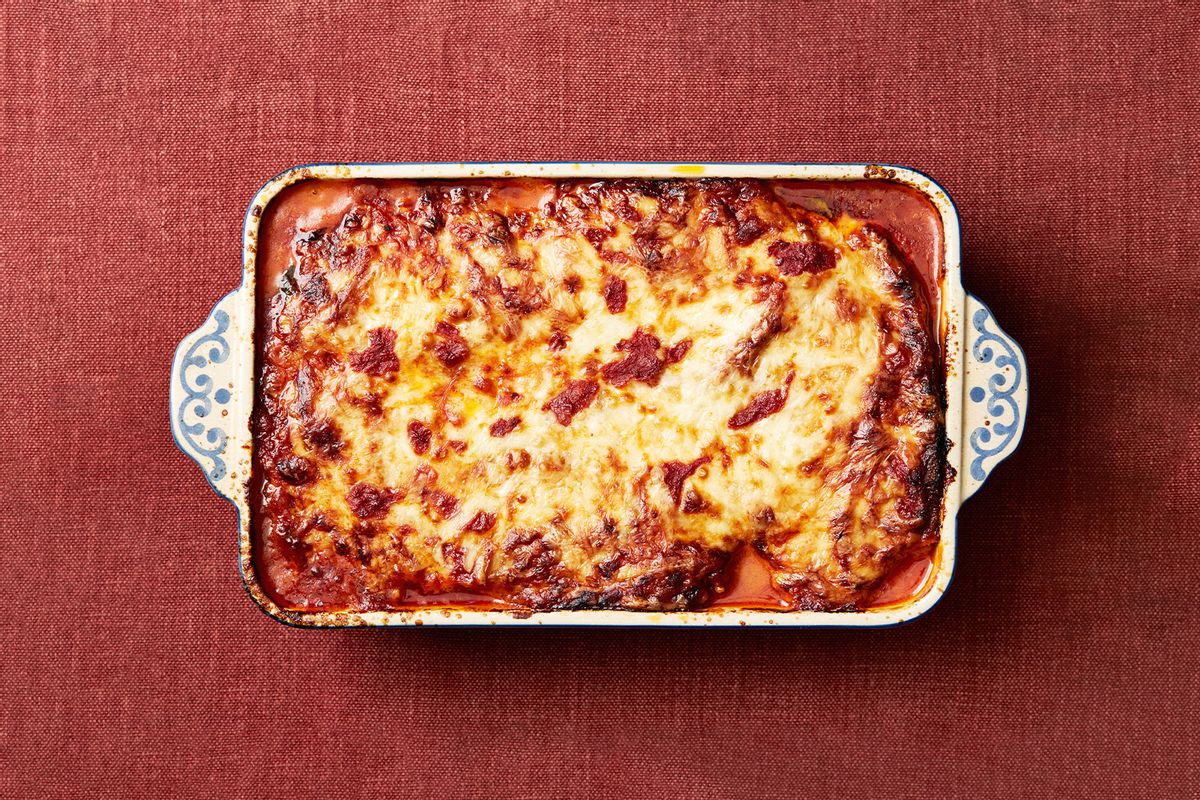Your ultimate guide to making the coziest, cheesiest, crispiest eggplant parmesan

I’ve said it before, but Italian-American food culture is truly my kryptonite. While chicken parmesan epitomizes comfort food for me, most recipes for it are incredibly similar (though my version does make sure the chicken actually stays super crisp).
But when it comes to eggplant parmesan, there are far more variables and choices to make. I’m here to help guide you through them and set you on your way to getting dinner started. So, let’s get right into it, shall we?
Eggplant size
While many opt for large, purple globe eggplants (like the emoji), that may not always be the wisest move. For those unacquainted with the world of eggplants, they can be . . . finicky. They can act like an oil sponge, they can be bitter, they can be heavily seeded, the skin can be tough — essentially, there’s a lot to be mindful of when working with eggplant.
In certain instances, I prefer to choose small eggplants that are about the size of mini cucumbers. While you may have to buy an inordinate amount of them to feed a crowd, they’re less generally bitter, cook up easier and more evenly and are usually simpler to work with at the core.
So, try picking up some small eggplants next time, and see if you notice a difference. Also, always opt for eggplants that are smooth and firm, with a slight shine on the skin and no dull marks or blemishes.
Peeled or not
When working with eggplants — especially in eggplant parm — I find that the skin can sometimes get in the way, add an unpleasant texture to an otherwise lovely bite or negatively impact the overall flavor profile. I once read that peeling them in strips – but leaving a bit of skin for structural integrity – is a great option to avoid any unappealing skin pieces.
Conversely, peeling the eggplant in its entirety is also an option, but be mindful that doing so may cause more oil leeching since the flesh itself is porous, which is otherwise “protected” when the skin is intact. Additionally, the breading also helps prevent any sort of sponge-like oil incidents, creating a barrier that – when properly fried – becomes a shatteringly crisp exterior that perfectly juxtaposes the smooth, creamy interior of the hot and perfectly cooked eggplant. It’s a tricky balance, but when done right, it’s downright stellar.
Casserole style
Many Italian-American households make eggplant parm in what I call “casserole style,” almost akin to how you’d make a ricotta-and-meat-free lasagna but with breaded and fried eggplant slices instead of pasta sheets or lasagna noodles. This manner is hearty and comforting, but it does devalue the work you put into frying the eggplant, which is also one of my biggest gripes with many chicken parm recipes.
If you’re accustomed to this “casserole style,” feel free to stick with it, but potentially stick the fried eggplant on top of your red sauce before covering with cheese to preserve the breading’s crispiness.
Planks vs. slices
Again, eggplant parm is traditionally made with thin slices of breaded eggplant. This is lovely, but sometimes the slices get soggy, stick or meld together during the baking process or are otherwise pretty skimpy in size. I prefer working with planks, peeling the eggplant, then cutting off the top and bottom before slicing lengthwise into three to four planks depending on the size. Conversely, if you’re opting for mini eggplants, all you have to do is peel (or not), then make one or two cuts and you’re done.
To salt or not to salt
Some eggplant aficionados swear by salting as a way to remove moisture and bitterness from the vegetable, while others think it’s completely unnecessary. Truly, it depends on your eggplant: the size, the season, the region in which it was grown, etc.
Removing any bitterness can be hit or miss — it’s highly dependent on the eggplant you’ve chosen. This does, however, pre-season the eggplant before breading it and can help reduce the “sponginess” of the eggplant, allowing it to crisp up better.
Rennet
While eggplant parm is the customary go-to vegetarian “parm” dish (personally, I’ve been smitten by Carmine’s portobello parmesan for years, but that’s a conversation for another day), many true-blue vegetarians are adamant about not consuming anything that has the name “parmesan” alongside it.
All “real” Parmesan or Parmigiano-Reggiano cheeses — along with related cheeses like Locatelli, pecorino, romano, etc. — are made with something called rennet, which is essentially a byproduct of cheesemaking that comes from cows.
Want more great food writing and recipes? Subscribe to “The Bite,” Salon Food’s newsletter.
There are non-rennet Parmesans out there, but they may not be available at all grocery stores. If you’re adamant about not eating Parmesan that includes rennet, feel free to seek out these alt-cheeses, or conversely, up the mozzarella and omit the Parmesan altogether. Rennet comes from the stomach of a calf and is a key ingredient in high-quality Parmesan cheese, but it’s certainly something to be avoided if you’re fully vegetarian.
Styles of mozzarella
I like to swear by full-fat, low-moisture, shredded mozzarella, or even an “Italian blend,” which sometimes includes provolone, asiago, pecorino and mozzarella. Many, however, opt for fresh mozzarella.
This part of the eggplant parm journey is totally up to you. The variations are pretty minor, and you may only notice a smidgen of a difference. The dish will be delicious and deeply comforting regardless.
That’s all, folks! To help cut this dish’s richness, be sure to pair it with a deliciously sharp and acidic green salad. Now, on to the recipe.
***
Crispy Eggplant Parmesan
Yields
6-8 servings
Prep Time
20 minutes
Cook Time
1 hour, plus time for cooling
Ingredients
- 2-3 large eggplants or 6-8 small eggplants, peeled (or not), cut however you’d like (slices or planks), salted about 5 to 10 minutes prior to cooking and then patted dry
- 3/4 cup all-purpose flour (or flour alternative if you’re looking to be GF)
- Kosher salt, to taste
- Freshly ground black pepper, to taste
- 2 teaspoons garlic powder, divided
- 2 teaspoons onion powder, divided
- 3 eggs (combined with 1 to 2 tablespoons milk of your choosing)
- 1 1/2 cup panko
- 1 1/2 teaspoons dried parsley
- 1 1/2 teaspoons dried oregano
- 2 cups Parmesan (or non-rennet vegetarian Parmesan), divided
- 2 cups neutral oil (vegetable, canola, peanut, safflower, etc.)
- Flaky salt
- 2 to 3 cups red sauce (click here for my red sauce recipe)
- 3 to 4 cups shredded mozzarella or Italian blend (depending on how outrageously cheesy you want it)
- 1 stick butter, cut into small squares, cold
- 2 tablespoons olive oil
- 1 cup fresh basil
Directions
- Prepare your standard breading procedure: In three shallow plates, divide the flour, egg-milk mixture and panko. In the flour, season with salt, pepper, onion powder and garlic powder. In the egg-milk mixture, season with salt and pepper. In the panko, add Parmesan (or alternative), onion powder, garlic powder, parsley, oregano, salt and pepper. Preheat the oven to 425 degrees Fahrenheit.
- Set a large, heavy-bottomed pot over medium heat and let the oil come to temperature.
- Season the eggplant with salt and pepper. Carefully dredge the eggplant into the flour, then the egg, then the panko, packing the panko tightly onto the eggplant. Repeat with all the eggplant pieces.
- Cook the eggplant in hot oil, frying without turning too often, and don’t overcrowd the pan. The cooked eggplant should be deeply browned, about 2 to 3 minutes each side. Transfer to a wire rack set over a cookie sheet and season with flaky salt immediately after removing the eggplant from the oil. Repeat and cook in batches until all the eggplant is cooked.
- On the bottom of a large casserole dish or sheet tray, spread out about a cup of tomato sauce. Combine the mozzarella (or Italian blend) with half the Parmesan (or alternative), then sprinkle half on top of the sauce. Add the eggplant, not overlapping, to the sheet tray or casserole dish, then top with another cup of sauce and the remaining cheese mixture. Carefully dot the top with little squares of butter. Transfer to the oven.
- Cook until the sauce is bubbling and the cheese is fully melted, about 30 minutes. Transfer to the broiler until the cheese is browned and crisped. Remove from the oven, drizzle with olive oil and let cool for 5 minutes.
- In a small pan, heat olive oil. Add the basil leaves and cook until the edges curl and crisp, then transfer to a paper towel-lined plate. Once cooled, crush the basil leaves and mix with the remaining Parmesan (or alternative) cheese. Drizzle over the top of the cooling eggplant parm.
- Serve immediately with a green salad and some crusty bread.
Read more
from this author
Salon Food writes about stuff we think you’ll like. Salon has affiliate partnerships, so we may get a share of the revenue from your purchase.


